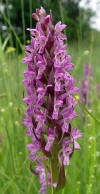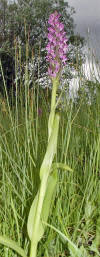Dactylorhiza incarnata
(LINNAEUS) SOÓ, 1755
Από τις πιο διαδεδομένες Δακτυλόριζες στην Ευρώπη, αλλά στην Ελλάδα εξαιρετικά σπάνια και φυόμενη μόνο στα βουνά της δυτικής Μακεδονίας. Ξεχωρίζει λόγω του στενόμακρου χείλους του άνθους και των ακηλίδωτων, λογχοειδών φύλλων που μόνο στο είδος αυτό ανέρχονται παράλληλα με τον βλαστό, φτάνοντας συχνά ως το ύψος της ταξιανθίας (φωτο Νο 4). Περιγράφονται πολλές ποικιλίες στην βόρεια Ευρώπη με κυρίαρχη την Dactylorhiza incarnata var. incarnata που έχει ερυθρο-ιώδη άνθη (βλέπε παρακάτω στην "Σημείωση"). Προτιμάει βαλτώδη, υγρά και αλκαλικά εδάφη και ανθίζει από τα τέλη Μαΐου ως τις αρχές Ιουνίου.
Σημείωση: Οι παρακάτω φωτογραφίες προέρχονται από βαλτώδη βιότοπο του Γράμμου που ευγενικά υποδείχθηκε από τον Dr Horst Kretzschmar. Μοναδικό φαινόμενο αυτής της ομάδας φυτών που απαρτίζεται από περίπου 50 άτομα είναι ότι τα μισά έχουν λευκά άνθη διατηρώντας όμως τα ιώδη σχέδια του χείλους του άνθους. Επίσης δεν παρουσιάζονται μορφές με ενδιάμεσο χρωματισμό άνθους. Στην κεντρική και βόρεια Ευρώπη περιγράφονται ποικιλίες και συγγενικές Δακτυλόριζες (Dactylorhiza incarnata var. ochrantha και Dactylorhiza ochroleuca) στις οποίες τα άνθη είναι ωχροκίτρινα και όχι λευκά και στερούνται της στίξης του χείλους. Προφανώς στην αποικία αυτή του Γράμμου εμφανίζονται σταθεροποιημένοι δύο κλώνοι φυτών που για άγνωστο λόγο δεν αναμιγνύονται.
![]()
One of the most widely distributed Dactylorhiza in Europe but extremely rare in Greece and growing only in few locations of northwestern Macedonia. Special characteristics are the narrow-elongated lip and the unspotted, long leaves which are ascending and parallel to the stem, frequently reaching the inflorescence (photo No4). In central and northern Europe, many varieties have been described with Dactylorhiza incarnata var. incarnata, which has red-purplish flowers, being the most widespread. It prefers marshy, alkalic soils and flowers from mid May to mid June.
Note: The following pictures are all coming from a marshy biotope of Grammos mountain which was very kindly indicated by Dr Horst Kretzschmar. Unique characteristic in this colony of about 50 plants is that half of them are having white flowers which reserve their purple design of the macula (not completely hypochromic). Also the colony has no intermediate colored plants. Some varieties and relative Dactylorhizas in central and northern Europe (Dactylorhiza incarnata var. ochrantha and Dactylorhiza ochroleuca) are having pale and not completely white flowers and they lack the macula drawings. Apparently in this Grammos' colony, two stable clones of Dactylorhiza incarnata are growing and for unknown reasons not mixing genetically.
Back to Orchids list




